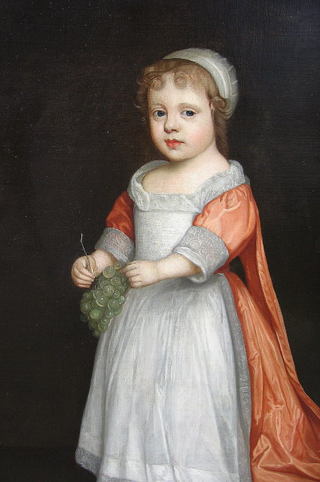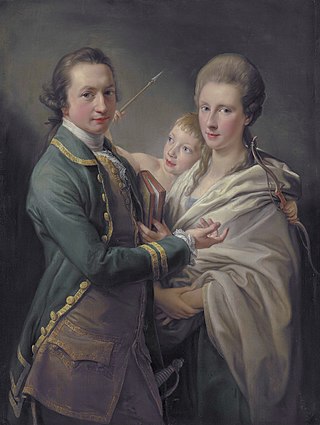Related Research Articles

Earl of Carlisle is a title that has been created three times in the Peerage of England.

Baron Dacre is a title that has been created three times in the Peerage of England, each time by writ.

Earl of Drogheda is a title in the Peerage of Ireland. It was created in 1661 for The 3rd Viscount Moore.

Anne Lennard, Countess of Sussex, formerly Lady Anne FitzRoy, was the eldest daughter of Barbara Villiers, mistress to King Charles II. She became the wife of Thomas Lennard, 1st Earl of Sussex.

Arthur Chichester, 3rd Earl of Donegall was an Irish nobleman and soldier.
Arthur Chichester, 2nd Earl of Donegall PC (Ire) was an Anglo-Irish politician.
William George Cavendish, 2nd Baron Chesham was a British Liberal politician.

Charles William Wentworth Fitzwilliam, 5th Earl Fitzwilliam in the peerage of Ireland, and 3rd Earl Fitzwilliam in the peerage of Great Britain, was a British nobleman and politician. He was president three times of the Royal Statistical Society in 1838–1840, 1847–1849, and 1853–1855; and president of the British Association for the Advancement of Science in its inaugural year (1831–2).

Arthur Saunders Gore, 2nd Earl of Arran, KP, PC (Ire), styled The Honourable Arthur Gore from 1758 to 1762 and Viscount Sudley from 1762 to 1773, was an Irish peer and politician.
Sir Roger Jones, 1st Viscount RanelaghPC (Ire) was joint Lord President of Connaught with Charles Wilmot, 1st Viscount Wilmot. He commanded the government forces in Connaught during the Irish Rebellion of 1641 and the beginning of the Irish Confederate Wars defending Athlone against James Dillon until February 1643.

Thomas Lennard, 1st Earl of Sussex, 15th Baron Dacre, was an English peer. He became Earl of Sussex in 1674 when he married Lady Anne Fitzroy, illegitimate daughter of Charles II and Lady Barbara Palmer. The Baron Dacre title became abeyant in 1715 following his death.
Henry Moore, 1st Earl of Drogheda PC (I) was an Anglo-Irish peer, politician and soldier.
Garret Moore, 1st Viscount Moore PC (I) was an Anglo-Irish politician and peer.
Edward Moore, 5th Earl of Drogheda PC (I) was an Anglo-Irish peer and politician.
Henry Moore, 4th Earl of Drogheda, styled Viscount Moore from 21 May to 7 June 1714, was an Irish peer and rake who briefly served in the Parliament of Great Britain. He inherited his title and estates at the age of 13, when his father and grandfather died in quick succession. Drogheda rapidly became a debauchee, and after squandering large sums, died at the age of 26, leaving his younger brother a heavily encumbered estate.
Lieutenant Colonel William Henry Wellesley, 2nd Earl Cowley was an English aristocrat and soldier.
The Honourable Charles Moore, styledViscount Moore, was a Member of the Irish Parliament for Drogheda.
The Honourable Robert Moore was an Anglo-Irish politician.
Henry Roper, 8th Baron Teynham was an English aristocrat

Thomas Barrett-Lennard, 17th Baron Dacre was an English aristocrat.
References
- ↑ Charles Kidd and David Williamson, editor, Debrett's Peerage and Baronetage (London: Debrett's Peerage, 1999), volume 12, page 1870.
- ↑ George Edward Cokayne, editor, The Complete Baronetage, 5 volumes (c. 1900); Gloucester: Alan Sutton Publishing, 1983), volume IV, page 463.
- 1 2 G.E. Cokayne; with Vicary Gibbs, H.A. Doubleday, Geoffrey H. White, Duncan Warrand and Lord Howard de Walden, editors, The Complete Peerage of England, Scotland, Ireland, Great Britain and the United Kingdom, Extant, Extinct or Dormant, new ed., 13 volumes in 14 (1910-1959; reprint in 6 volumes, Gloucester: Alan Sutton Publishing, 2000), volume IV, page 463.
- ↑ John Debrett, Debrett's Peerage of England, Scotland, and Ireland (1840), p.249.
- ↑ O'Sullivan, Harold (1995). "Women in County Louth in the Seventeenth Century". Journal of the County Louth Archaeological and Historical Society. 23 (3): 366–367. doi:10.2307/27729780. JSTOR 27729780 . Retrieved 22 September 2023.
- ↑ Hayton, David; Cruickshanks, Eveline; Handley, Stuart (2002). The House of Commons, 1690-1715. Cambridge University Press. p. 549. ISBN 978-0-521-78318-7 . Retrieved 7 March 2024.
- 1 2 3 4 5 6 7 8 9 Mosley, Charles, editor. Burke's Peerage, Baronetage & Knightage, 107th edition, 3 volumes. Wilmington, Delaware: Burke's Peerage (Genealogical Books) Ltd, 2003, volume 1, pp. 1180-1182.
- ↑ Ireland, National Library of (1965). Manuscript Sources for the History of Irish Civilisation. G. K. Hall. pp. 571–575, 946. Retrieved 7 March 2024.
- ↑ Cruickshanks, Eveline. "MOORE, Henry, 4th Earl of Drogheda [I] (1700-27)". www.historyofparliamentonline.org. History of Parliament Online . Retrieved 7 March 2024.
- ↑ Cokayne, George Edward (1916). The Complete Peerage of England, Scotland, Ireland, Great Britain, and the United Kingdom: Dacre to Dysart. St. Catherine Press, Limited. p. 464. Retrieved 7 March 2024.